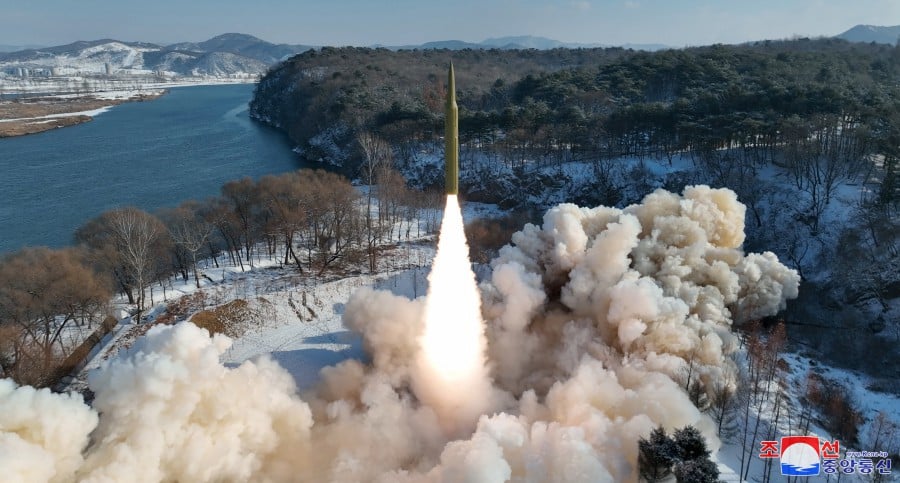
North Korea carried out its first ballistic missile test this year on Sunday by launching an Intermediate Range Ballistic Missile (IRBM) into the Sea of Japan. North Korea’s Missile Administration said it was a test-fire of an “intermediate-range solid-propellant ballistic missile loaded with a hypersonic mobile control warhead,” according to state media.
On Monday the state-controlled Korean Central News Agency claimed the test was successful and was to confirm the gliding and maneuvering flight characteristics of the mid-to-long-range rapid hypersonic maneuvering combat unit and the reliability of the newly developed multi-stage high-output solid fuel engine.
“The test-fire never affected the security of any neighboring country and had nothing to do with the regional situation,” according to KCNA.
Earlier on Sunday, South Korea’s Joint Chiefs of Staff issued a statement that said at 2:55 p.m., the South Korean military detected a ballistic missile launched from the vicinity of the North Korean capital of Pyongyang heading to the East Sea, also known as the Sea of Japan. The missile flew for 620 miles before splashing into the East Sea according to the JCS, who condemned the launch.
“We strongly condemn the North Korean missile launch as a clear act of provocation that gravely threatens the peace and stability of the Korean Peninsula,” said the JCS.
The South Korean military monitored and tracked the missile along with sharing the information with the U.S. and Japan and is analyzing information gathered on the missile launch and flight.
“The [Republic of Korea] military will keep a close watch on North Korea’s various activities and maintain its capabilities and posture to overwhelmingly respond to any provocations under a firm ROK-U.S. joint defense posture,” reads the statement.
On Dec. 19 last year, the United States, Japan and South Korea announced that the three countries had fully activated a real-time North Korea missile warning system that allowed them to share data in real-time on any North Korean missile launches.
In an interview with Yonhap News Agency on Thursday, South Korean Defense Minister Shin Won-sik stated that North Korea could test fire IRBMs early this month along with launching ballistic missiles as part of a strategic campaign of provocations prior to South Korea’s parliamentary elections in April and the U.S. presidential election in November. From Jan. 5-7, North Korea conducted artillery firings in coastal areas at the maritime border of the two countries.
Japan’s Ministry of Defense on Sunday issued a different estimation on the range that the missile flew, saying that the missile flew for 310 miles at a maximum altitude of 31 miles before landing in the Sea of Japan near the east coast of the Korean Peninsula, outside Japan’s Exclusive Economic Zone. On Monday, during his regular daily press conference. Japan Chief Cabinet Secretary Hayashi Yoshimasa was asked on the difference between the Japanese and South Korean estimates and replied that each country made its own determination and that based on Japan’s own information gathering, the initial assessment was that the missile flew for at least 310 miles. Hayashi also stated that Japan, South Korea and the U.S would continue to gather information on the launch and that the three countries were working around the clock in sharing information and how to deal with the launch.
U.S Indo-Pacific Command issued a short statement on Sunday saying that it was consulting closely with allies and partners and that while it assessed that the event does not pose an immediate threat to U.S. personnel or territory, or to U.S. allies, the missile launch highlights the destabilizing impact of North Korea’s illicit weapons program, “the U.S. commitment to the defense of the Republic of Korea and Japan remains ironclad. The ROK, Japan, and the U.S., trilaterally coordinated operations to ensure protection of their respective nations” concluded the release.
Also on Monday, Japan’s Joint Staff Office (JSO) issued a release stating that on Friday at 11 p.m., People’s Liberation Army Navy (PLAN) Dongdiao-class intelligence ship Tianshuxing (795) was sighted sailing southeast in an area 130km northeast of Miyako Island. On Saturday, the PLAN ship sailed through the Miyako Strait to enter the Philippine Sea before turning back and sailing northwest through the Miyako Strait to return to the East China Sea. Japan Maritime Self Defense Force (JMSDF) minesweeper JS Shishijima (MSC-691), a JMSDF P-1 Maritime Patrol Aircraft (MPA) of Fleet Air Wing 1 based at JMSDF Kanoya Air Base, Kyushu and a JMSDF P-3C Orion MPA of Fleet Air Wing 5 from Naha Air Base, Okinawa tracked the PLAN ship, according to the release.





